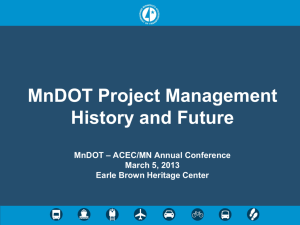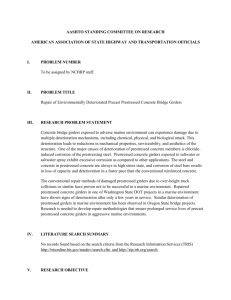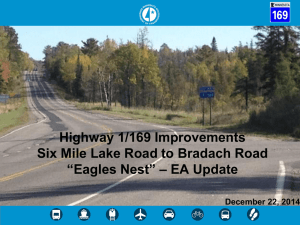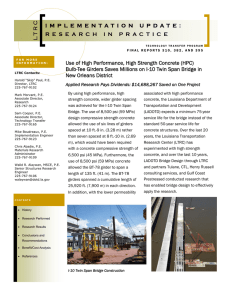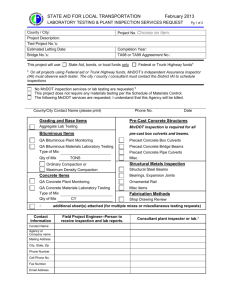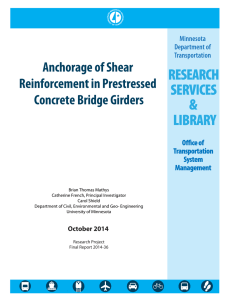RESEARCH SERVICES & LIBRARY MnDOT’s Concrete Bridge Girder Design
advertisement
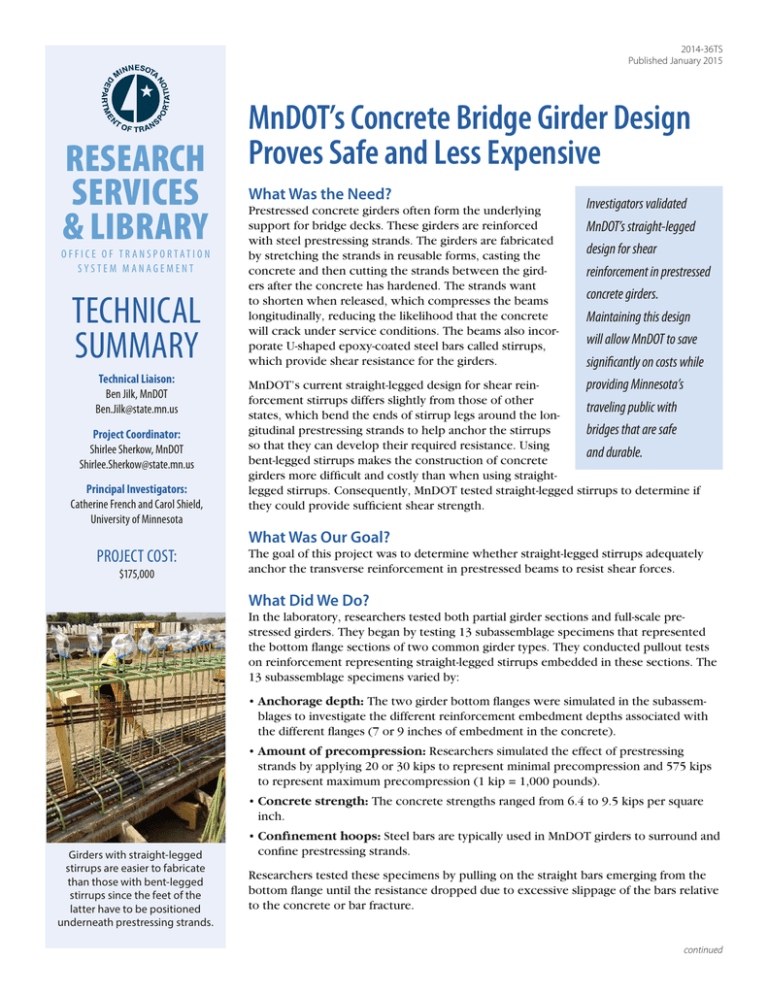
2014-36TS Published January 2015 RESEARCH SERVICES & LIBRARY O FFICE O F TR ANSP O R TATI O N SYSTEM MANAGEMENT TECHNICAL SUMMARY Technical Liaison: Ben Jilk, MnDOT Ben.Jilk@state.mn.us Project Coordinator: Shirlee Sherkow, MnDOT Shirlee.Sherkow@state.mn.us Principal Investigators: Catherine French and Carol Shield, University of Minnesota PROJECT COST: $175,000 MnDOT’s Concrete Bridge Girder Design Proves Safe and Less Expensive What Was the Need? Prestressed concrete girders often form the underlying support for bridge decks. These girders are reinforced with steel prestressing strands. The girders are fabricated by stretching the strands in reusable forms, casting the concrete and then cutting the strands between the girders after the concrete has hardened. The strands want to shorten when released, which compresses the beams longitudinally, reducing the likelihood that the concrete will crack under service conditions. The beams also incorporate U-shaped epoxy-coated steel bars called stirrups, which provide shear resistance for the girders. Investigators validated MnDOT’s straight-legged design for shear reinforcement in prestressed concrete girders. Maintaining this design will allow MnDOT to save significantly on costs while providing Minnesota’s traveling public with bridges that are safe and durable. MnDOT’s current straight-legged design for shear reinforcement stirrups differs slightly from those of other states, which bend the ends of stirrup legs around the longitudinal prestressing strands to help anchor the stirrups so that they can develop their required resistance. Using bent-legged stirrups makes the construction of concrete girders more difficult and costly than when using straightlegged stirrups. Consequently, MnDOT tested straight-legged stirrups to determine if they could provide sufficient shear strength. What Was Our Goal? The goal of this project was to determine whether straight-legged stirrups adequately anchor the transverse reinforcement in prestressed beams to resist shear forces. What Did We Do? In the laboratory, researchers tested both partial girder sections and full-scale prestressed girders. They began by testing 13 subassemblage specimens that represented the bottom flange sections of two common girder types. They conducted pullout tests on reinforcement representing straight-legged stirrups embedded in these sections. The 13 subassemblage specimens varied by: • Anchorage depth: The two girder bottom flanges were simulated in the subassemblages to investigate the different reinforcement embedment depths associated with the different flanges (7 or 9 inches of embedment in the concrete). • Amount of precompression: Researchers simulated the effect of prestressing strands by applying 20 or 30 kips to represent minimal precompression and 575 kips to represent maximum precompression (1 kip = 1,000 pounds). • Concrete strength: The concrete strengths ranged from 6.4 to 9.5 kips per square inch. Girders with straight-legged stirrups are easier to fabricate than those with bent-legged stirrups since the feet of the latter have to be positioned underneath prestressing strands. • Confinement hoops: Steel bars are typically used in MnDOT girders to surround and confine prestressing strands. Researchers tested these specimens by pulling on the straight bars emerging from the bottom flange until the resistance dropped due to excessive slippage of the bars relative to the concrete or bar fracture. continued “Using bent-legged stirrups would increase the cost of fabricating prestressed concrete girders in Minnesota. This study showed that these extra costs are unnecessary.” —Ben Jilk, Principal Engineer, MnDOT Bridge Office “This project has helped MnDOT verify that its current stirrup design for prestressed bridge girders is more than adequate to resist shear forces.” To test stirrup anchorage, researchers used an MTS Model 311 high-force test system to apply compression to the subassemblage specimens while tugging on stirrup bars. Then they tested two full-scale prestressed concrete girders by applying loads to investigate how well straight-legged stirrups resisted shear forces. Girder specimens varied by girder depth (36 and 45 inches), anchorage depth (6.76 and 8 inches) and stirrup spacing (8 to 24 inches). What Did We Learn? —Catherine French, CSE Distinguished Professor, University of Minnesota Department of Civil, Environmental and Geo-Engineering Both subassemblage and full girder test results showed that MnDOT’s straight-legged stirrups are well-anchored and more than adequate for resisting shear forces. In subassemblage tests, the use of confinement hoops did not make an observable difference to the strength of stirrup anchorage. However, higher amounts of precompression clearly improved anchorage, as did the deeper embedment of bars in MN-shaped girders. In full girder tests, shear capacities exceeded those predicted by AASHTO standard specifications by 19 to 38 percent, and Load and Resistance Factor Design specifications by 9 to 52 percent. These percentages might have been higher if researchers had tested girders to the point of failures. Several factors lead to successful stirrup performance, including the prestress in the girder and the embedment of the straight-legged stirrups within the bottom flange surrounded by additional longitudinal reinforcement that helps to resist potential splitting cracks. What’s Next? Produced by CTC & Associates for: Minnesota Department of Transportation Research Services & Library MS 330, First Floor 395 John Ireland Blvd. St. Paul, MN 55155-1899 651-366-3780 www.mndot.gov/research MnDOT will use girders with the straight-legged stirrup design because they are easier to construct than bent-legged girders. With concrete by far the most common material used for bridges in Minnesota, maintaining its current design will allow MnDOT to save significantly on costs while providing Minnesota’s traveling public with bridges that are safe and durable. This Technical Summary pertains to Report 2014-36, “Anchorage of Shear Reinforcement in Prestressed Concrete Bridge Girders,” published October 2014. The full report can be accessed at http://www.lrrb.org/PDF/201436.pdf.
